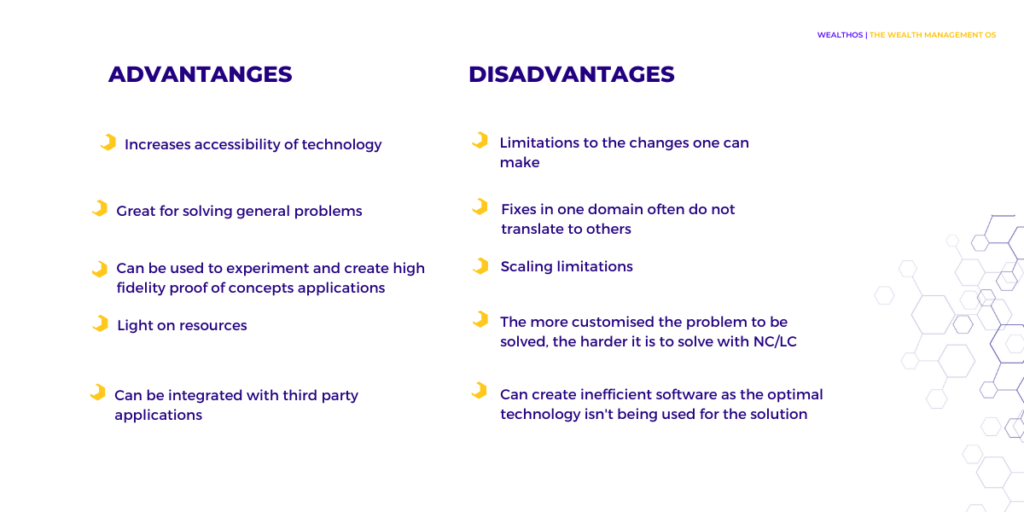By Shri Krishnansen Posted on
How to create software without (hardly) needing to code

Do you ever think, “if only software programming was easier… I could automate this boring task, or stop paying someone else to do this, or even rule the world?” The problem you want to solve is probably a lot smaller than the amount of coding you would have to learn to solve. We use technology all the time and now the ability to solve that work problem or take on a new side hustle, with technology doing the heavy lifting, is literally at your fingertips.
For a time, coding was inaccessible to the public, only available to those who had the time and willingness to learn another language — e.g., Python or Java. The perception that you had to also be good at mathematics or science to code served as an additional hurdle.
Early Days of Coding
The early days of coding looked a lot like something out of a Matrix movie – a whole lot of ones and zeros — and the reason for that is because, at its very core, the language that is being used to speak to hardware is written in Binary code.
You need large chunks of ones and zeros to correspond to specific instructions and specific things to do. The idea that this process could be more efficient led to the development of ‘languages’ to abstract away from Binary code. So, you could type a string of text that then corresponds to huge chunks of Binary code.
The first evolution away from Binary code was the idea of programming languages, of which there are many – Python, Java, C++, Scala, JavaScript etc.
Python’s one of the most famous programming languages today as its most used in data engineering and analysis. JavaScript is often used for front-end or visual interface of a website.
Revolution of No-Code/Low-Code
Over time, we started asking the question, is it possible to build an even higher layer of extraction that is not just text-based, but visual? That way, people don’t have to learn all the strings of text, instead, they can just drag and drop visual cues, that in turn correspond to code, to create a software application. Vive la low-code/no-code!
No-Code
A no-code application doesn’t require you to write a single line of code, and you’ve probably used them already.
All configurations through a no-code application are done through a graphic user interface. In just a few clicks, before you know it, an automated process flow or animation is being created in the background. There’s lots of code that is being pieced together, but you’ve just been dragging and dropping.
No-code applications are very template-based, often with limitations or boundaries in how much you can customise them.
How does a low-code application compare?
Both no-code and low-code have the same philosophy; to help people with very low or almost no coding knowledge use technology. However, with low code, you do need a little bit of code to maximise the application’s potential. So, while you can get by without needing to write much code, if you want to customise it, you can write some code to plug in the gaps.
This evolution of no-code/low-code applications has led to two new types of developers – the citizen developer and the power user.

Empowering people with technology
People who use a no-code environment are known as citizen developers. Citizen developers are deep domain experts. For example, a lawyer, a doctor, or a business practitioner, who wants to use an IT application for their business case. Instead of having to learn how to write Python or Java, they can use a no-code application to build software without having to write a single line of code. No-code apps allow domain experts to retain their expertise and do what they do best while leveraging technology to power and create efficiencies.
Power users are interested in solving a problem but they want to maximise what they can do with the software. So, they go further by creating custom scripts and code within low-code applications.
That’s all folks for our ‘non-techie’ low down on low code.
To find out more about how WealthOS uses low-code/no-code within our platform, you can check out our video here.
If you offer digital wealth management products, like investing and retirement apps, and need third-party integrations to enhance your customer experience, onboard your clients, manage payments, etc., you can sign up to our sandbox for free and experience no-code integrations first-hand.
Our sandbox allows you to experience the WealthOS platform and experiment for free! You can build high-fidelity prototypes within weeks to showcase your ideas – be it for business case approvals or to unlock fundraising. Whatever the use case, our sandbox is here to let you explore for free.
So come on down and sign up to innovate today!
